Innovative wireless network solutions from the ARIADNE project
Angeliki Alexiou
University of Piraeus
Marco Di Renzo
Centre national de la recherche scientifique –
CentraleSupelec
marco.direnzo@
centralesupelec.fr
Reconfigurable Intelligent Surfaces (RIS), which are made of materials able to dynamically shape electro-magnetic wave fronts, are nearly passive devices that can adapt or change the radio signals between the transmitters and receivers. As explored in the ARIADNE project, one of the pioneer European actions in this area, the dynamically controlled RIS open a new dimension in designing and operating the next generation of wireless networks, 6G.
Recent research results confirm that effective deployment of RIS as controllable surfaces can enhance network capacity and coverage, but also create opportunities for future applications such as positioning and localisation. The RIS can be designed as a self-configuring part of a wireless network infrastructure, adjusting its electromagnetic characteristics in response to dynamic traffic demand and propagation characteristics.

RIS attached to a house enabling communications avoiding obstacles
Usage scenarios
To investigate usage of RIS in D bands, the ARIADNE project developed several static and dynamic use cases and corresponding scenarios. A typical scenario with RIS attached to a house, enabling communications and avoiding obstacles, is presented in the figure, where a user is still able to communicate with a base station via RIS, even though a tree is blocking the communication. Similar scenarios are considered also for indoor environments.
How Reconfigurable Intelligent Surfaces work
A RIS is a planar surface that consists of an array of passive scattering elements (approximate size in the range of 1 cm2), each of which can independently impose the required phase shift, and possibly an amplitude gain, on the incident electromagnetic waves. By carefully adjusting the phase shifts and the amplitudes of all the scattering elements, the reradiated electromagnetic waves can be shaped to propagate towards specified directions, with the help of an attached RIS controller. In this way, we are able to establish so-called alternative links within a cell using RIS and allow communication in non-line-of-sight (NLOS) scenarios – see the figure.
The main advantage of RIS usage is that they are almost passive elements involving very low-power electronics, representing an environment friendly and low-cost solution which can be easily deployed at walls, ceilings, billboards, lampposts, event vehicles, etc. On the other hand, the absence of power amplifiers and digital signal processing capabilities at RIS naturally pose some design challenges and a trade-off consideration between the coverage range of the surface, its size, and the number of RIS elements that need to be deployed on it.
Network challenges
Even though the RIS application is a promising solution to enhance the future 6G communications networks, there is still a need to perform related research on channel characterization, signal processing, physical RIS design, and more. The ARIADNE project is complementing the world-wide research activities in this field by working towards a research framework for establishing a novel network concept called Beyond Shannon smart radio environment.
Furthermore, future networks will have very high network requirements, demanding a highly dynamic control of the RIS-based wireless network infrastructure. To address this, a full optimization for dynamically controlling RIS-based networks could be achieved through accurate, but very complex mathematical models. The complexity could be handled via Artificial Intelligence (AI) technologies, which might be able to ensure that networks respond swiftly to changing data traffic situations, where the RIS structure is configured and dynamically changed in accordance with the current network demands.
Outlook
The ARIADNE project has done pioneer research work by targeting a full characterization, modelling, and performance analysis of the networks applying RIS. Towards the project end in 2022, ARIADNE will demonstrate the RIS application in one of its usage scenarios and develop a concept for managing RIS-supported wireless networks by applying AI. Finally, the ARIADNE project has been engaged in discussions on the needed standardization steps including RIS from the beginning, and is actively participating in a corresponding ETSI Industry Specification Group (ISG) on RIS, established in September 2021.
Further information:
ARIADNE project website – https://www.ict-ariadne.eu


